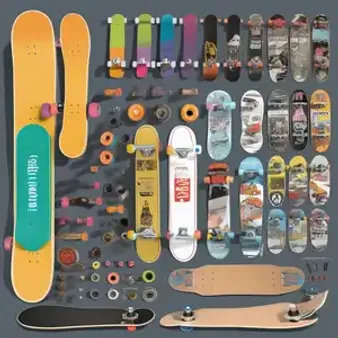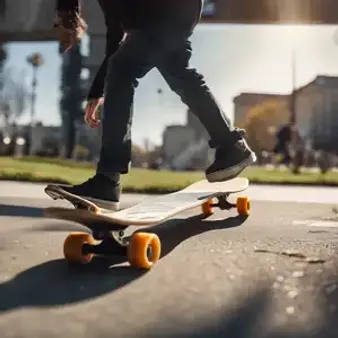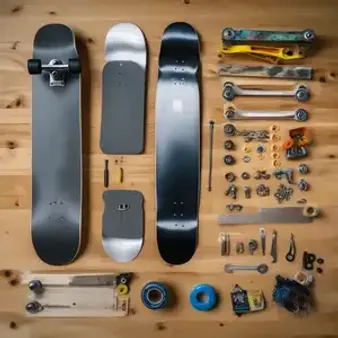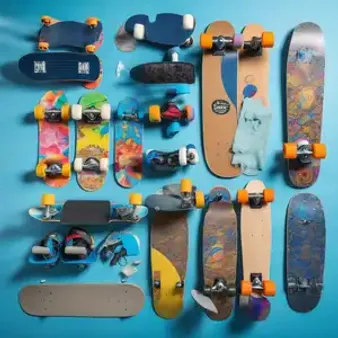Table of Contents
Ready to ride? A skateboard kit is the perfect starting point for anyone interested in experiencing the thrill of skateboarding. At kizworld, we want to equip you with the knowledge to choose the perfect skateboard kit, understand its parts, assemble it with ease, and take those exciting first steps on your board. Let's get rolling!
Feature | Description |
|---|---|
Skateboard Deck | The flat board you stand on, typically made of wood. Choose a size and shape that suits your riding style. |
Trucks | Metal components that attach the wheels to the deck and allow for turning. |
Wheels | Made of polyurethane, they come in various sizes and hardnesses for different riding surfaces. |
Bearings | Small metal rings that fit inside the wheels, allowing them to spin smoothly. |
Grip Tape | A sandpaper-like material applied to the top of the deck, providing grip for your feet. |
Hardware | Nuts and bolts used to assemble the different parts of the skateboard. |
Understanding Skateboard Kit Components
Alright, new skater, let's break down the anatomy of your soon-to-be awesome skateboard kit! Think of it like baking a cake – you need the right ingredients to whip up something delicious. In a skateboard kit, you've got these key parts:
The Deck - Your Board's Foundation
First up is the deck – the flat board you stand on. It's usually made of wood, like a tough cookie but way cooler. Decks come in different sizes and shapes, kinda like how pizzas come in different sizes. Smaller decks are easier to maneuver if you're just starting out or want to do tricks. Larger decks are more stable for cruising or if you have bigger feet. You can learn more about finding the perfect board for your style in our article about choosing the right skateboard.
- Length: Measured in inches, affects stability.
- Width: Measured in inches, impacts foot placement.
- Shape: Concave (curved inward) for better control.
Trucks - The Turning Point
Next, we've got trucks – the metal parts that connect the wheels to the deck. They're like the steering wheel of your skateboard, letting you turn and carve. Trucks have bushings inside that affect how stiff or loose your steering feels. Stiffer bushings mean less turning but more stability, while looser bushings are better for quick turns and tricks. Ever seen a skateboarder smoothly grind a rail? Check out our guide on how to grind to see this in action!
Wheels - Rollin', Rollin', Rollin'
Now for the fun part – wheels! These bad boys are made of polyurethane (say that five times fast!) and determine how smooth your ride is. Wheels come in different sizes and hardnesses: smaller, harder wheels are great for street skating and tricks, while larger, softer wheels are better for cruising and rough surfaces. Want to learn some cool tricks? We've got you covered with our guide on how to do a kickflip.
Understanding Skateboard Kit Components
Choosing the Right Skateboard Kit for You
Picking the right skateboard kit is like choosing your superhero ride! First, think about where you'll be skating. Smooth streets? A skateboard for your style with smaller, harder wheels is like having racing tires - perfect for speed and tricks. If you're tackling bumpy sidewalks or the skatepark, bigger, softer wheels are like having monster truck tires - they'll roll over anything! Don't forget about the deck size. Imagine trying to balance on a dinner plate versus a serving tray - a smaller deck is easier to handle for beginners and tricks, while a larger deck offers more stability if you've got bigger feet.
Wheel Size | Best For |
|---|---|
Smaller, Harder Wheels | Street Skating, Tricks |
Larger, Softer Wheels | Cruising, Rough Surfaces |
Choosing the Right Skateboard Kit for You
Assembling Your Skateboard Kit
Okay, so you've got your awesome skateboard kit – it's like having all the parts to build your own spaceship! Now, let's put it all together. Don't worry, it's easier than it looks, and way more fun than putting together furniture with your parents!
Attaching the Trucks to the Deck
First, grab your trucks and those little metal things called baseplates. They're like the feet of your trucks. You'll see holes on the baseplates that line up with the holes on your deck. Now, grab your hardware (nuts and bolts) – they're like the screws that hold everything together. Push the bolts through the holes from the top of the deck, then screw the nuts on from the bottom. Make sure they're snug but not too tight – you want your trucks to be able to move freely. You can learn more about finding the perfect board for your style in our article about choosing the right skateboard.
Tools | What You Need |
|---|---|
Skate Tool | This handy tool has all the right sizes to tighten and loosen your skateboard parts. |
Wrench | If you don't have a skate tool, a wrench can work too. Just make sure it fits the nuts on your hardware! |
Adding the Wheels and Bearings
Time for the wheels! Remember those bearings – the little metal rings that make your wheels spin? Each wheel needs two bearings. Carefully push a bearing into each side of the wheel. You might need to give it a little push with your hands or gently tap it with something soft. Now, slide the wheels onto the axels of your trucks (those metal rods sticking out). If they don't slide on easily, don't force them! Make sure the bearings are seated properly in the wheels. Once the wheels are on, tighten the axle nuts just enough to hold the wheels in place but still allow them to spin freely. Imagine spinning a top – that's how freely your wheels should spin! You can find out more about skateboarding in our guide.
Assembling Your Skateboard Kit
Essential Tips for Skateboard Kit Beginners
Alright, you've got your skateboard kit and you're ready to roll! First things first, safety is key. Imagine yourself as a superhero – you wouldn't go fighting villains without your helmet and pads, right? Same goes for skateboarding. Protect that awesome brain of yours and pad up those knees and elbows. Trust me, falling happens, but it's all part of the learning process. Check out our guide on helmets and pads for the best protection. Start slow – don't try to become Tony Hawk on day one. Think of it like learning to ride a bike. You wouldn't hop on and immediately try to do a wheelie (unless you're some kind of prodigy!). Find a smooth, flat surface like a driveway or parking lot and practice getting comfortable on your board. Get the hang of balancing, pushing off, and turning before you start tackling tricks or hills.
Safety Gear | Why It Matters |
|---|---|
Helmet | Protects your head from serious injury. Always wear one! |
Knee Pads | Shield your knees from bumps and scrapes. |
Elbow Pads | Protect your elbows if you take a tumble. |
Essential Tips for Skateboard Kit Beginners
Final Thought
Starting your skateboarding adventure with a skateboard kit is an exciting and rewarding experience. Remember to prioritize safety, practice consistently, and most importantly, have fun! With dedication and the right kit, you'll be carving up the streets in no time. Happy skating!